
According to Newsweek, the U.S. government is considering “The Salvador Option”–setting up assassination squads to target leaders of the Iraqi resistance. We speak with journalist and activist Allan Nairn whose 1984 article in The Progressive Magazine titled “Behind the Death Squads” exposed the CIA’s backing of El Salvador death squads and led to an investigation by the Senate Intelligence Committee. [includes rush transcript]
As violence in Iraq continues into 2005, the U.S. government is considering setting up assassination squads to target leaders of the Iraqi resistance. Newsweek Magazine is reporting that the Pentagon is drawing up possible proposals to send special forces teams to advise, support and train hand-picked Iraqi squads to target Sunni rebels.
Within the Pentagon, the tactic is named “The Salvador option” after the strategy that was secretly employed by Ronald Reagan’s administration to combat the guerrilla insurgency in El Salvador in the early 1980s. The U.S.-backed death squads hunted down and assassinated rebel leaders and their supporters.
The current US ambassador in Iraq is John Negroponte. As ambassador to Honduras, Negroponte played a key role in coordinating US covert aid to the Contras who targeted civilians in Nicaragua and shoring up a CIA-backed death squad in Honduras.
The Newsweek report says the Iraqi squads would most likely be made up of Kurdish Peshmerga fighters and Shiite militiamen and could even operate across the Syrian border. It is also still unclear whether Pentagon or the CIA would take responsibility for the squads.
We are joined right now by journalist and activist Allan Nairn. In 1984, his article in The Progressive Magazine entitled “Behind the Death Squads” [Download pdf] exposed the CIA”s backing of El Salvador death squads and led to an investigation by the Senate Intelligence Committee.
- Allan Nairn, investigative journalist and activist. To read Allan’s reports, go to: newsc.blogspot.com.
Transcript
AMY GOODMAN: The Intelligence Committee came out with a 400-page report, which never saw the light of day. I believe there were only two copies made, but let’s ask Allan Nairn. Welcome to Democracy Now!
ALLAN NAIRN: Thanks.
AMY GOODMAN: It’s good to have you with us. Can you talk about what this Salvador option means, hearing about the Newsweek report that they might employ it in Iraq?
ALLAN NAIRN: Well, Newsweek said that — they described the Salvador option as the targeting of combatants and their sympathizers, and the key word is sympathizers. In El Salvador, and not just Salvador, but about three dozen other countries, the U.S. government, in an integrated effort involving the CIA, the Pentagon and the State Department, backed the creation of military units that targeted civilian activists. In Salvador, I interviewed many of the officers involved in running these squads. For example, General “Chele” Medrano, who was on the CIA payroll, described how they picked their targets. He said they targeted people who speak—and these are his words—”against yankee imperialism, against the oligarchy, against military men. These people are traitors to the country. What can the troops do? When they find them, they kill them.” Actually, they didn’t always kill them. Often they brought them to the headquarters of the treasury police, the national guard, the army, and they tortured them for days. One former member of the Salvadoran treasury police, René Hurtado, described a course that was given at army general staff headquarters, where American officers gave instruction in techniques including electroshock torture. Hurtado himself said he conducted such torture. He said—these are his words: “You put wires on the prisoner’s vital parts. You place the wires between the prisoner’s teeth, on the penis, in the vagina. The prisoners feel it more if their feet are in the water, and they’re seated on iron, so the blow is stronger. … When it’s over, you just throw him in the alleys with a sign saying, Mano Blanco, ESA (Secret Anticommunist Army), or Maximiliano Hernandez Brigade.” These are the names of the Salvadoran death squads. I was given a chance to see the archives of the Salvadoran national police, the intelligence archives, and you could see they had files marked “union,” “student,” “religious.” They showed me a card file, which included surveillance reports on activists who had traveled to other countries. These surveillance reports were given to them, according to the captain who was giving me this tour, by the CIA. The whole filing system was set up for them by the U.S. Agency for International Development. Medrano was at one point brought to the oval office in the White House, and presented a silver medal by president Lyndon Johnson for an–he showed me the medal, inscribed on the medal–for exceptionally meritorious service. This program actually began not just under Reagan, but during the John F. Kennedy administration. It encompassed all of Latin America or all of the dictatorships of Latin America that were being backed the by the U.S. in the Central American region, it included Salvador, Guatemala, Nicaragua, and Honduras. A special teletype system, which at that time was the top technology, was set up for exchanging information among the intelligence services of the various participant countries, where information would be passed back and forth about, for example, labor leaders who would travel from one country to another for conferences, and then on their return, they would be picked up, tortured and assassinated. Something on the order of 75,000 Salvadoran civilians were killed by the Salvadoran military, most of them during the ’70s. And the majority of these were targeted by these death-squad-type forces. So, one point is, these were not combatants who were being killed. These were not armed guerrillas. They were sometimes engaged by the Salvadoran military in combat, but the death squad operations, which the Pentagon, according to Newsweek, is now talking about using for Iraq, these went after civilians.
AMY GOODMAN: We’re talking to Allan Nairn. You talk about General Medrano, who is known as the father of these death squads, trained by the United States in El Salvador. Again, this 20 years ago. And I’m looking at a full-page ad that The Progressive took out in the Washington Post, “Behind the Death Squads,” an exclusive report on the U.S. role in Salvador’s official terror. Can you talk about the effect of this, and how this information was made known?
ALLAN NAIRN: Well, based on some of those interviews that I just described and also U.S. internal documents I did that article for The Progressive. They published, I think it was May of 1984 and it was almost completely ignored by the corporate press. There was no notice whatsoever. So then The Progressive went out and raised money from various donors, and they were able to buy a full-page ad in the Washington Post where they reprinted about a third of the article. This got some attention in Washington. The U.S. Senate Intelligence Committee then asked me to come in, and meet with them. So I did in a closed session and was questioned by dozens of the Intelligence Committee staff for about three or four hours about what the U.S. had done to back and create the Salvadoran death squads. Now this was a bit curious since they were the ones, who had security clearance, who had access to the C.I.A. and Pentagon files. They were the ones who worked with them, indeed funded them, but they were asking me, I think in part maybe to try to find out how much I knew. What I knew is what I printed in the magazine, but I was trying to spur them to investigate. And they did. They then launched an investigation where they say they examined more than a million internal documents. They produced a 400 page report, which was heavily classified. They told me that only two copies of the report were produced, one was in a sealed room that only — kept on Capitol Hill, which only the Senators on the committee could read, and another at the C.I.A. headquarters. A public report was released, which said nothing. Some of the Senators told me that the classified–they told me a little bit about the classified report. They said they had verified that in fact, yes, the U.S. had set up these death squads in Salvador and also that U.S. personnel had sometimes been on the premises during torture sessions and had supplied questions for the prisoners being tortured.
AMY GOODMAN: So, this was back in 1984 and 1985 when this was coming back — coming out. Did it surprise you that the Pentagon is actually calling this proposal, according to Newsweek, to train — it’s not clear if it’s C.I.A.-backed, Pentagon-backed assassination and kidnapping squads in El Salvador, that they’re calling it the Salvador option. Have they ever acknowledged it publicly?
ALLAN NAIRN: Well, it sounds … No, they never acknowledged it publicly. That Senate report was classified. But now it sounds like in an offhand way, it’s almost — it sounds as if they’re almost talking about it even in a — almost a joking way, oh yeah, we’ll do to them what they did to Salvador. It’s an astonishing admission, but I think now that this is on the record, immediately, the Senate Intelligence Committee should release their classified report of 1984, and there should be a demand that the Pentagon and the C.I.A. release all internal documents they have about the Salvador option, and similar activities in Guatemala, Honduras, Nicaragua, Salvador, also–there are dozens of other countries in the world where this has happened. Recently, we had the revelations about General Pinochet and his bank account, the Riggs Bank in Washington. He was paid millions by the U.S. as a very similar intelligence exchange system and assassination system was being set up the southern cone countries. This admission should be pursued, and the U.S. officials who participated in creating units that killed civilians should be prosecuted for murder. We have to enforce the murder laws.
AMY GOODMAN: The nuns, the American nuns it is referred to in the Newsweek piece, that were killed in El Salvador, Allan. Can you give some background as we — as the Pentagon apparently weighs this option of the Salvador option in Iraq?
ALLAN NAIRN: They were killed by the Salvadoran National Guard. They were pulled from their vehicle, raped, shot, dumped into a ditch, and this was a typical Salvadoran death squad operation. This one got a lot of the attention in the press in the U.S., because victims were American. Although at the time, U.S. officials actually tried to excuse it, Alexander Haig, I believe it was Alexander Haig spoke publicly about there being an exchange of gunfire, which implied these were pistol packing nuns who had to be brought down in combat by the Salvadoran forces. Jean Kirkpatrick actually said, well, these were not real nuns, her suggestion being that they were activists and this somehow — she seemed to be suggesting this somehow legitimized their targeting. That was in fact the principle behind these death squad operations.
AMY GOODMAN: And then the Jesuits who were killed in El Salvador, not to mention the archbishop of El Salvador Oscar Romereo.
ALLAN NAIRN: Archbishop Romero was killed as part of the — according to later investigations, he was killed by an offshoot of the operation of Roberto D’Aubuisson who ran the ARENA party, which was one of the death squad operations or one of the smaller one, actually. The larger came from the regular Salvadoran armed forces and police. He also had U.S. backing. In fact, D’Aubuisson launched his career as a major figure in Salvador by going on TV and making a speech. He had a video role as he spoke with an illustrated death list of union people and religious figures and others who he said should be killed as traitors to the country. And the data for the list were supplied to him by American intelligence, again according to the officers there I interviewed.
AMY GOODMAN: Now, one link between Salvador 20 years ago and today in Iraq is the former U.S. ambassador to Honduras, John Negroponte, who is the current ambassador to Iraq. And I also want to get to Aceh and talk about the latest that’s happening there, but in just a minute, if you could sum up that link.
ALLAN NAIRN: Well, Negroponte was one of the people who ran the Contra operation, the central — the invasion against Nicaragua, which the world court later ruled to be an act of aggression by the Contras, which were created and funded by the U.S. government. He also oversaw the back — the military backing for Battalion 316, which was a Honduran military death squad that specialized in torture and assassination.
AMY GOODMAN: And so, what it means that he is in charge of Iraq right now. Do you think he has a part of designing this “Salvador option?”
ALLAN NAIRN: Maybe not. They probably have other people who are specialists in that. He’s probably handling the economic side of it, but if there are political apologies to be done, Negroponte may handle it. The thing is that these programs, which backed the killing of foreign civilians, it’s a regular part of U.S. policy. It’s ingrained in U.S. policy in dozens upon dozens of countries. In Indonesia for example, which we are going to talk about in a minute, where the tsunami hit, the Kopassus, the Red Berets, which there specialize in torture and assassination, they have been trained by U.S. Green Berets in things like urban warfare. This is a longstanding policy, and it’s nothing new.

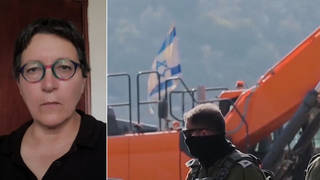
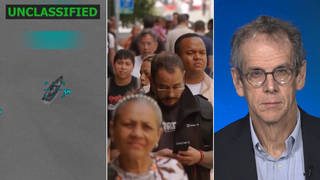
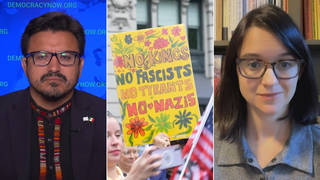
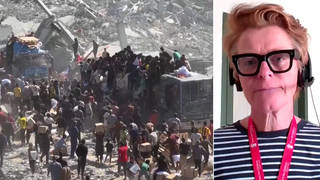






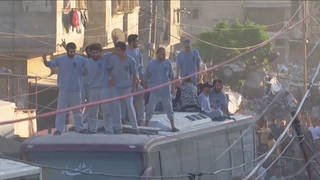
Media Options